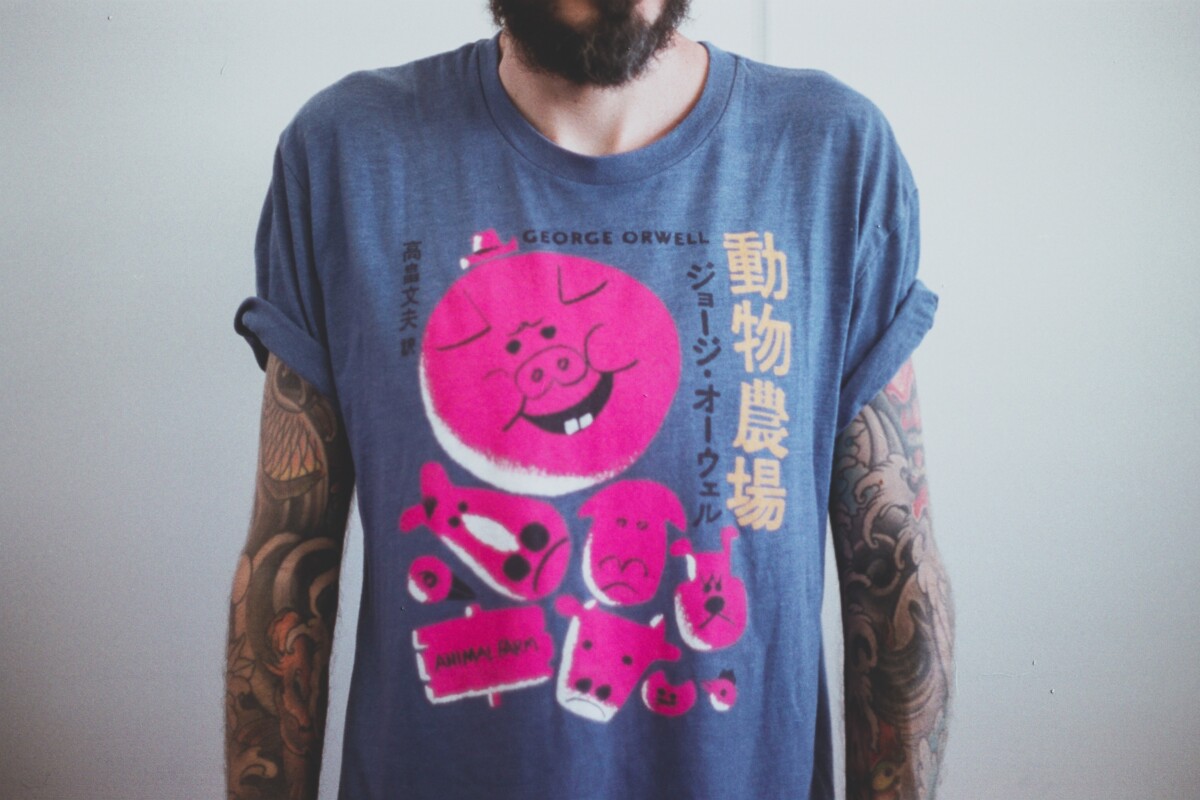For many bands, creating music, playing shows, and gaining fans are the primary goals. However, it’s important not to overlook the value of band merchandise. Merchandise can help to establish a band’s brand and create a sense of community among fans. When fans wear band merchandise, they are essentially promoting the band and helping to spread the word about their music.
Merchandise provides a significant source of revenue for bands and can supplement traditional revenue streams such as music sales and live shows. Merchandise can also be sold at a higher profit margin, making it a potentially lucrative venture. Additionally, band merchandise can increase fan engagement and loyalty by demonstrating support for the band and creating a sense of community.
Overall, band merchandise is an essential aspect of band culture that can benefit the band and its fans. In the following sections, we’ll explore the different types of band merchandise, how to design effective merchandise, and tips for selling and promoting merchandise effectively.
- Benefits of Band Merchandise
- The Different Types of Band Merch
- Choosing the Right Merch
- How to Design Effective Band Merch
- Selling Your Band’s Merch
- Promoting Your Band’s Merch
- How to Maximize Merch Sales
- Creating Your Own Merch
Whether you’re a seasoned musician or just starting out, these tips, and related questions can help you understand the importance of music merchandise for artists.

Credit: Stheart — Facebook
BENEFITS OF BAND MERCHANDISE
Band merchandise is not just a way for bands to make money — it is a way for them to promote their brand, increase fan engagement and loyalty, and promote their music. By creating high-quality merchandise that resonates with fans, bands can create a deeper connection with their audience and increase their overall success.
So, whether you’re a new band just starting out or an established act looking to expand your brand, creating a merch line should be a key part of your strategy. Here are some reasons why:
ADDITIONAL SOURCE OF REVENUE
Band merchandise can be a valuable source of revenue for bands. While music sales and live shows are typically the main sources of income for bands, merchandise can provide a steady stream of income even when the band is not actively touring or releasing new music. Selling merchandise can help supplement income from these other sources and provide an additional revenue stream for bands.
Additionally, merchandise is often sold at a higher profit margin than music sales. This is because the cost of producing merchandise is often lower than the cost of producing music. As a result, bands can make more money per item sold than they would from a music sale. This makes merchandise a more lucrative venture for bands.
Here’s a table that outlines the typical revenue split for bands:
| Source of Revenue | Typical Revenue Split |
|---|---|
| Record Sales | 15-20% of net profits |
| Live Performances | 70-80% of gross revenue (after expenses) |
| Merchandise Sales | 30-50% of net profits |
| Publishing | 50% of net profits |
It’s important to note that these percentages are approximate and can vary widely depending on several factors, such as the band’s popularity, their touring schedule, and the types of deals they have with their record label, management, and other partners.
Additionally, many bands rely on multiple sources of revenue to support their careers and may have different revenue splits for different income areas.
INCREASE FAN ENGAGEMENT & LOYALTY
One of the most significant benefits of band merchandise is its ability to increase fan engagement and loyalty. Fans who purchase band merchandise are showing their support for the band and are more likely to attend shows and purchase music. This creates a sense of community and connection between the band and its fans.
In addition to supporting the band financially, purchasing merchandise also creates a deeper sense of connection and involvement with the band’s culture and identity. Fans who wear band merchandise identify themselves as part of the band’s community, creating a sense of belonging and shared identity among fans. This, in turn, can lead to increased loyalty and enthusiasm for the band.
Merchandise can also serve as a way for bands to reward their most loyal fans. By offering exclusive or limited edition merchandise, bands can create a sense of exclusivity and appreciation for their most dedicated followers. This creates a deeper sense of connection and loyalty among these fans, which can lead to increased support and promotion for the band.
Band merchandise can also be used to create unique experiences and interactions between the band and its fans. For example, bands may offer meet-and-greet packages that include exclusive merchandise or other perks. This creates a more intimate and personal connection between the band and its fans, which can lead to increased loyalty and enthusiasm.
PROMOTES THE BRAND
Merchandise is not just a way for bands to make money—it also promotes their brand. Fans who wear band t-shirts, hats, or other merchandise become walking advertisements for the band. This can help to increase their visibility and reach. When fans wear band merchandise, they show their support for the band and promote it to others.
Merchandise also serves as a way to increase fan engagement and loyalty. Fans who purchase and wear band merchandise demonstrate their support for the band and are more likely to attend shows and purchase music. This creates a sense of community and connection between the band and its fans. Bands can use merchandise to reward their most loyal fans, creating a deeper sense of connection and loyalty.
PROMOTES THE MUSIC
Finally, band merchandise helps to promote the band’s music. Merchandise often features album artwork, song lyrics, or other elements related to the band’s music. This serves as a reminder to fans to check out the band’s music and can lead to increased music sales and streams. When fans wear merchandise that features the band’s name or album artwork, they promote the band’s music to others.
Merchandise can also serve as a souvenir for fans who attend shows or purchase music. When fans purchase merchandise, they take home a piece of the band’s culture and history. This creates a sense of nostalgia and connection between the band and its fans.
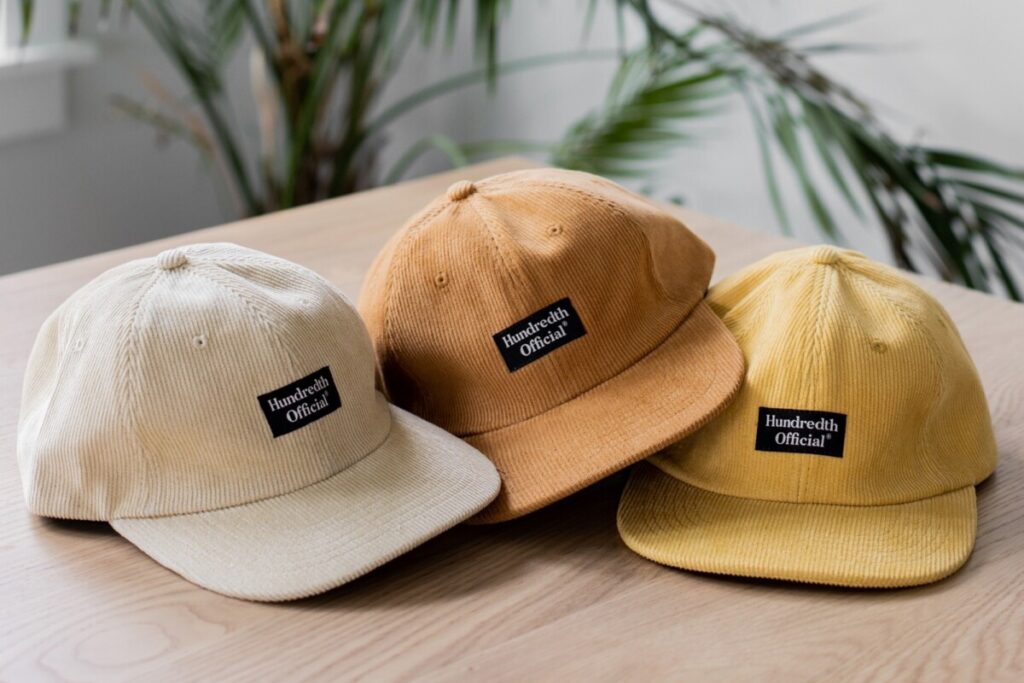
Credit: Hundredth — Facebook
THE DIFFERENT TYPES OF BAND MERCH
Creating band merchandise offers a wide range of options to choose from, such as t-shirts, hats, stickers, and posters, among others. These items can be customized with the band’s name, logo, or artwork, and produced in different styles, materials, and colors.
It’s important to consider what types of items will resonate with fans and be profitable for the band. By understanding what types of merchandise will be successful, bands can create a profitable merch line that resonates with fans and supports their overall success.
T-SHIRTS
T-shirts are one of the most popular types of band merchandise, as they are relatively inexpensive to produce and are a staple of fan wardrobes. Band t-shirts typically feature the band’s name or logo and artwork or imagery representing the band’s brand.
Some bands may choose to produce t-shirts for specific albums or tours, which can create a sense of exclusivity and make the merchandise more appealing to fans.
HATS
Hats are another popular type of band merchandise and can be a great way to expand a band’s merch line. Hats can be customized with embroidered logos or artwork and produced in various styles, such as snapbacks or beanies.
Hats are a great option for fans who want to show their support for the band more subtly or for a practical item they can wear daily.
POSTERS
Posters are a classic type of band merchandise that have been around for decades. Posters can be produced in various sizes, from small 11×17 prints to large 24×36 posters. Band posters typically feature album artwork, tour dates, or other imagery related to the band’s music.
Posters can be a great option for fans who are looking to decorate their homes or bedrooms with items that represent their favorite bands.
STICKERS
Stickers are another popular type of band merchandise that are relatively inexpensive to produce. Stickers can be customized with the band’s name, logo, or artwork and produced in various sizes and shapes.
Stickers are a great option for fans who want to show their support for the band in a fun and lighthearted way.
PHYSICAL MUSIC
Physical music such as CDs, vinyl records, tapes, and USB drives can be considered a type of merchandise for bands. In addition to being a source of revenue, physical music can also serve as a way for fans to connect with a band’s music in a tangible way.
CDs and vinyl records, in particular, have become popular collector’s items for music fans, and many bands use them as a way to promote their music and build their brand. Therefore, physical music can be a valuable addition to a band’s overall merchandise strategy.
KEYCHAINS, PATCHES, & PINS
Other types of band merchandise include keychains, patches, and pins. These items can be customized with the band’s logo or artwork and produced in various styles and materials. Keychains, patches, and pins are great options for fans who want to show their support for the band subtly or for fans looking for unique and collectible items.
CHOOSING THE RIGHT MERCH
When choosing merchandise to produce, it’s important to consider what items will resonate with fans and what items will be profitable for the band. Bands should consider the costs of production, as well as the potential profits that can be generated from each item.
It’s also important to consider what items are popular with fans and what is unique to the band’s brand. By understanding what types of merchandise will be most successful, bands can create a successful and profitable merch line that resonates with fans and supports their overall success.
Here’s a table that outlines some of the most common types of band merchandise:
| Type of Merchandise | Description | Examples |
|---|---|---|
| T-shirts | Apparel featuring the band’s name, logo, or artwork | Tour t-shirts, album-specific t-shirts, logo t-shirts |
| Hats | Headwear featuring the band’s name, logo, or artwork | Snapback hats, beanies, trucker hats |
| Posters | Prints featuring album artwork, tour dates, or other imagery related to the band’s music | Album art posters, tour posters, limited edition prints |
| Stickers | Adhesive decals featuring the band’s name, logo, or artwork | Vinyl stickers, bumper stickers, laptop stickers |
| Keychains | Small items featuring the band’s name, logo, or artwork that can be attached to keys or other items | Metal keychains, acrylic keychains, rubber keychains |
| Patches | Small fabric patches featuring the band’s name, logo, or artwork that can be sewn onto clothing or bags | Embroidered patches, woven patches, iron-on patches |
| Pins | Small metal pins featuring the band’s name, logo, or artwork that can be attached to clothing or bags | Enamel pins, button pins, collectible pins |
| Physical Music | Physical copies of the band’s music, including CDs, vinyl records, tapes, and USB drives | Vinyl records, CDs, cassette tapes, USB drives |
This is not an exhaustive list, as many other types of band merchandise can be produced. However, these are some of the most common types of merchandise that bands may choose to produce.

HOW TO DESIGN EFFECTIVE BAND MERCH
REFLECT THE BRAND
Designing effective band merchandise is essential to creating a successful merch line. A band’s merchandise should reflect their brand and be visually appealing to fans. One way to do this is to incorporate album artwork or logos into the design, which can create a sense of cohesiveness between the band’s music and their merchandise. Alternatively, bands can create custom artwork associated with their brand, such as designs featuring lyrics or themes important to the band’s music.
WORK WITH A SKILLED DESIGNER
When designing merchandise, it’s important to work with a skilled designer who understands how to create designs that will resonate with fans. Designers should be able to create designs that are visually appealing, easy to read, and sized correctly for the specific type of merchandise being produced. Bands should also consider the cost of design when creating their merch line, as more complex designs may be more expensive to produce.
CHOOSE THE RIGHT VENDOR
In addition to designing effective merchandise, choosing the right vendor for the job is important. Bands should research vendors who specialize in producing band merchandise, as they will have the necessary expertise to create high-quality items. When choosing a vendor, bands should consider the quality of their products, the cost of production, and their turnaround time. Working with vendors with a track record of producing high-quality merchandise is important, as this will help ensure that the band’s merchandise is well-received by fans.
UNDERSTAND THE PRODUCTION PROCESS
Understanding the production process is also crucial when creating band merchandise. Bands should work with their chosen vendor to understand how the merchandise will be produced, what materials will be used, and how long the production process will take. This will help bands to ensure that their merchandise is produced on time and to their specifications and will help to prevent any unexpected delays or production issues.
By working with a skilled designer and choosing the right vendor, bands can create effective and visually appealing merchandise that resonates with fans and supports their overall success. By taking the time to design and produce high-quality merchandise, bands can increase their revenue and connect with fans in new and meaningful ways.
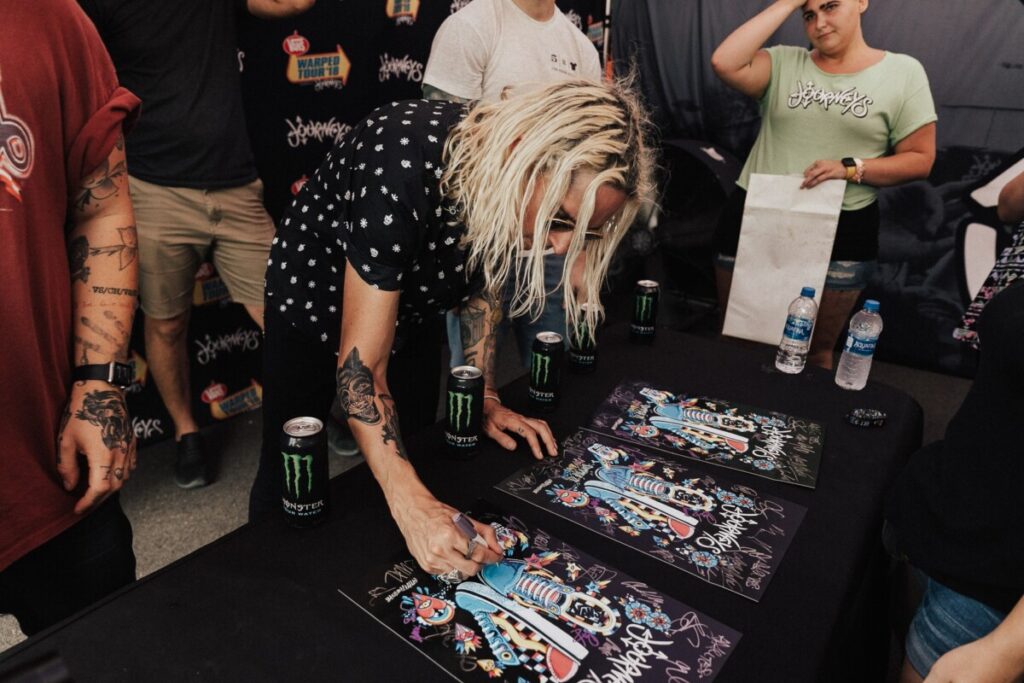
Credit: Vans Warped Tour — Facebook
SELLING YOUR BAND’S MERCH
SELL AT LIVE SHOWS
One of the best ways to sell your band’s merch is at live shows. Fans who attend your shows are often the most passionate and engaged and are more likely to purchase your merchandise. Set up a merch table or booth at your shows and display your items prominently. Consider offering package deals or discounts for fans who purchase multiple items.
SELL ONLINE
In addition to selling at live shows, selling your band’s merch online is a great way to reach a wider audience. Set up an online store on your band’s website or use an online marketplace such as Bandcamp or Shopify to sell your merchandise. Make sure to include high-quality photos of your items and detailed descriptions that will help fans make informed purchasing decisions.
OFFER LIMITED EDITION ITEMS
Creating limited edition or exclusive items can be a great way to generate buzz and excitement around your merchandise. Consider producing a limited run of t-shirts or posters that are only available for a short time, or create special items that are only available at specific shows or events.
PROMOTING YOUR BAND’S MERCH
USE SOCIAL MEDIA
Social media is a powerful tool for promoting your band’s merchandise. Share photos of your items on Instagram or Facebook, and include links to your online store or upcoming shows. Consider partnering with influencers or other bands in your genre to promote your merchandise to a wider audience.
GIVEAWAYS & CONTESTS
Hosting giveaways or contests on social media can be a great way to promote your merchandise and engage with fans. Consider giving away a piece of merch to a lucky fan who shares a photo of themselves wearing or using your merchandise, or host a contest where fans can submit their own designs for a chance to have their artwork featured on a future piece of merchandise.
PARTNER WITH RETAILERS
Partnering with retailers such as record stores or clothing boutiques can be a great way to reach new fans and promote your merchandise. Contact local retailers in your area or consider partnering with online retailers specializing in band merchandise.
Collaborating with other musicians is also a great way to sell more merch. Check out our list of Essential Benefits of Collaborating with Other Musicians.
By combining these strategies, you can effectively sell and promote your band’s merchandise, build your brand, and increase your revenue. Remember to be creative and innovative when promoting your merchandise, and stay true to your band’s brand and identity.
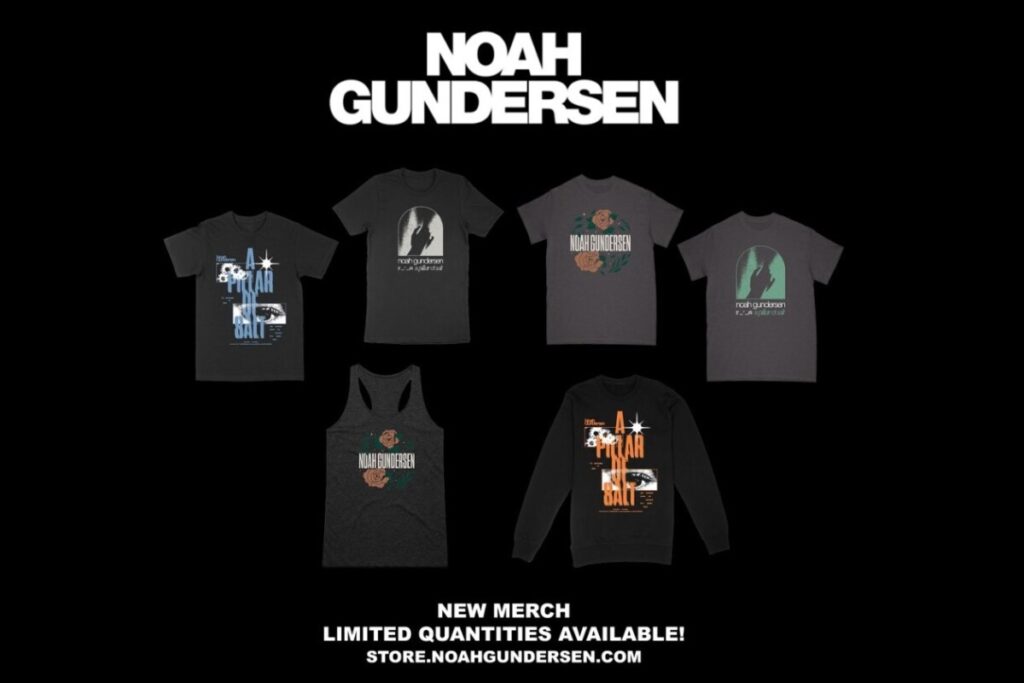
Credit: Noah Gundersen — Facebook
HOW TO MAXIMIZE MERCH SALES
To make the most of their merchandise, bands can consider a number of different strategies to increase sales and encourage fans to make a purchase. Some effective strategies include bundling merchandise, offering personalized packaging, partnering with brands or charities, and accepting a variety of payment types. By being creative and innovative in their approach to merchandising, bands can increase revenue and build a loyal and engaged fan base.
OFFER MERCH BUNDLES
Merchandise bundles can be a great way to increase sales and encourage fans to purchase multiple items. Bundling merchandise together allows fans to get more for their money and can create a sense of exclusivity around the merchandise.
To create an effective merch bundle, consider grouping together items that are related or have a theme in common. For example, you could bundle together a t-shirt, poster, and sticker that all feature the same artwork or design.
Alternatively, you could create bundles that correspond to specific events, such as a bundle featuring merchandise from a specific show or tour. When pricing your bundles, be sure to offer a discounted price that makes it clear to fans that they are getting a good deal.
ACCEPT ALL PAYMENT TYPES
To make it as easy as possible for fans to purchase your merchandise, accept a wide variety of payment types. In addition to cash and credit cards, consider accepting digital payment methods such as PayPal, Venmo, and Apple Pay. These payment options are especially important for online sales, as they allow fans to easily make purchases from their computers or mobile devices.
When accepting digital payments, be sure to choose a secure payment processor and clearly communicate your payment options to fans.
OFFER FREE MERCH WITH PURCHASE
Offering free merchandise with a purchase is a great way to encourage fans to buy more items and can create a sense of excitement and anticipation around your merchandise. Consider offering a free sticker or pin with the purchase of a t-shirt, or a free poster with the purchase of a vinyl record. You could also offer a free download of a new song or exclusive content with the purchase of any merchandise.
When promoting your free merchandise, be sure to clearly communicate the terms and conditions of the offer and make it easy for fans to take advantage of the promotion.
HIRE A MERCH MANAGER
A merch manager can help your band maximize merch sales by handling all aspects of your band’s merchandise. They can assist with designing and producing appealing and high-quality merchandise, managing inventory, developing sales strategies, and promoting your online store.
Essentially, a merch manager can help streamline the process of selling merchandise, making it easier for fans to purchase items and increasing the likelihood of more sales.
PERSONALIZE YOUR PACKAGING
Personalizing your merchandise packaging is a great way to make your merchandise stand out and create a memorable experience for fans. Consider adding custom packaging or including a personalized note with each order. You could also use custom tissue paper or stickers to wrap your merchandise and create a cohesive brand experience.
When personalizing your packaging, be sure to choose materials that are high-quality and that will protect your merchandise during shipping.
PARTNER WITH BRANDS OR CHARITIES
Partnering with brands or charities can be a great way to reach new fans and promote your merchandise. Consider partnering with a brand that aligns with your band’s values or a charity that supports a cause important to your band. You can create custom merchandise that supports the partnership and donate a portion of the proceeds to the charity.
When partnering with a brand or charity, be sure to choose a partner that aligns with your band’s brand and message, and clearly communicate the details of the partnership to your fans.
By implementing these strategies and being creative in your approach to merchandising, your band can maximize sales and build a strong and engaged fan base.
By taking advantage of these strategies, your band can not only maximize sales but also create a more engaged fan base that feels a deeper connection to your music and brand. Merchandise can be more than just a source of revenue — it can be a powerful tool for building a community around your music and creating a sense of belonging for fans.
By being creative and thoughtful in your approach to merchandising, you can create merchandise that fans will love and that reflects the values and aesthetic of your band.
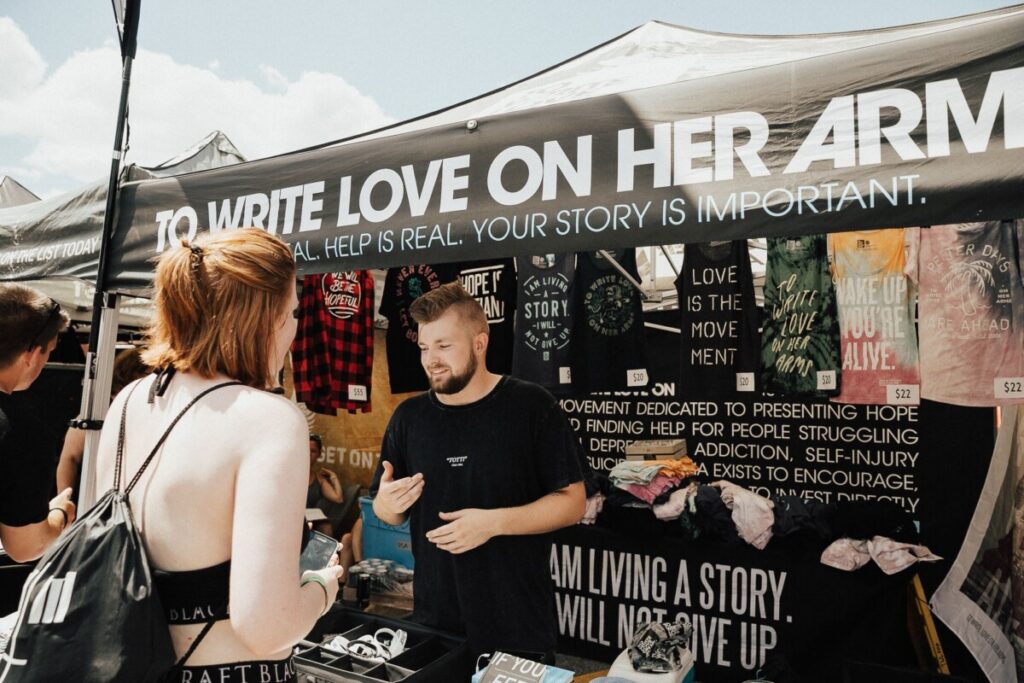
Credit: Vans Warped Tour — Facebook
CREATING YOUR OWN MERCH
Band merchandise is a critical aspect of band culture that can provide numerous benefits to bands beyond just a source of revenue. By offering a range of merchandise options, bands can engage with their fans and promote their brand in a way that supports their overall success. From t-shirts to posters to stickers, bands have a wide range of options to choose from when it comes to designing and creating their merchandise line.
Check out this video of Chadwick Johnson on Hundredth’s DIY approach to making merch.
Moreover, band merchandise can effectively promote a band’s music and increase their visibility. By wearing a band t-shirt or displaying a band poster, fans become walking billboards for the band’s brand, promoting their music and spreading the word to others. This can help to attract new fans and expand the band’s reach, which is critical for long-term success in the music industry.
Overall, band merchandise should be viewed as an important aspect of any band’s overall strategy and one that should not be overlooked. By investing in high-quality designs, selecting the right types of merchandise, and promoting merchandise effectively, bands can increase their revenue, strengthen their brand, and engage with their fans in a meaningful way. So if you’re a band looking to increase your revenue and reach new fans, consider creating your own merch line today.
RELATED QUESTIONS
How can bands design effective merchandise?
To design effective merchandise, bands should consider factors such as their brand identity, fan preferences, and current fashion trends. Bands should also invest in high-quality designs and materials to ensure that their merchandise stands out and appeals to fans.
How can bands promote their merchandise effectively?
To promote their merchandise effectively, bands can use a variety of strategies, such as social media marketing, influencer partnerships, and email marketing. Bands should also make sure to have a clear and organized merchandise display at live shows and make it easy for fans to purchase by accepting multiple forms of payment.
What are some potential drawbacks of creating merchandise?
Some potential drawbacks of creating merchandise include the upfront costs of production, the risk of unsold inventory, and the need to manage inventory and shipping logistics. Bands should carefully consider these factors and create a merchandise strategy that is financially viable and sustainable for their business.
What are some examples of successful band merchandise lines?
Many examples of successful band merchandise lines include the Rolling Stones’ tongue logo t-shirts, Metallica’s iconic “Master of Puppets” t-shirt, and the Grateful Dead’s psychedelic tie-dye shirts. Each of these examples showcases a unique and recognizable design that has become synonymous with the band’s brand.
How can merchandise help bands connect with their fans?
Merchandise can help bands connect with their fans by providing a tangible way for fans to show their support and connect with the band’s brand. By wearing a band t-shirt or displaying a band poster, fans can feel a sense of connection to the band and other fans who share their love for the band’s music.
For more industry tips and music marketing hacks, check out Ennui Magazine. You can also follow us on Facebook, Twitter, Instagram, Pinterest, and YouTube.
